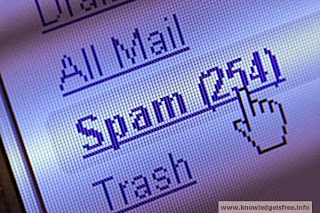Spam is flooding the Internet with many copies of the same message, in an attempt to force the message on people who would not otherwise choose to receive it. Most spam is commercial advertising, often for dubious products, get-rich-quick schemes, or quasi-legal services. Spam costs the sender very little to send -- most of the costs are paid for by the recipient or the carriers rather than by the sender.
There are two main types of spam, and they have different effects on Internet users. Cancellable Usenet spam is a single message sent to 20 or more Usenet newsgroups. (Through long experience, Usenet users have found that any message posted to so many newsgroups is often not relevant to most or all of them.) Usenet spam is aimed at "lurkers", people who read newsgroups but rarely or never post and give their address away. Usenet spam robs users of the utility of the newsgroups by overwhelming them with a barrage of advertising or other irrelevant posts. Furthermore, Usenet spam subverts the ability of system administrators and owners to manage the topics they accept on their systems.
Email spam targets individual users with direct mail messages. Email spam lists are often created by scanning Usenet postings, stealing Internet mailing lists, or searching the Web for addresses. Email spams typically cost users money out-of-pocket to receive. Many people - anyone with measured phone service - read or receive their mail while the meter is running, so to speak. Spam costs them additional money. On top of that, it costs money for ISPs and online services to transmit spam, and these costs are transmitted directly to subscribers.
One particularly nasty variant of email spam is sending spam to mailing lists (public or private email discussion forums.) Because many mailing lists limit activity to their subscribers, spammers will use automated tools to subscribe to as many mailing lists as possible, so that they can grab the lists of addresses, or use the mailing list as a direct target for their attacks.
There are two main types of spam, and they have different effects on Internet users. Cancellable Usenet spam is a single message sent to 20 or more Usenet newsgroups. (Through long experience, Usenet users have found that any message posted to so many newsgroups is often not relevant to most or all of them.) Usenet spam is aimed at "lurkers", people who read newsgroups but rarely or never post and give their address away. Usenet spam robs users of the utility of the newsgroups by overwhelming them with a barrage of advertising or other irrelevant posts. Furthermore, Usenet spam subverts the ability of system administrators and owners to manage the topics they accept on their systems.
Email spam targets individual users with direct mail messages. Email spam lists are often created by scanning Usenet postings, stealing Internet mailing lists, or searching the Web for addresses. Email spams typically cost users money out-of-pocket to receive. Many people - anyone with measured phone service - read or receive their mail while the meter is running, so to speak. Spam costs them additional money. On top of that, it costs money for ISPs and online services to transmit spam, and these costs are transmitted directly to subscribers.
One particularly nasty variant of email spam is sending spam to mailing lists (public or private email discussion forums.) Because many mailing lists limit activity to their subscribers, spammers will use automated tools to subscribe to as many mailing lists as possible, so that they can grab the lists of addresses, or use the mailing list as a direct target for their attacks.



No comments:
Post a Comment